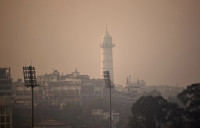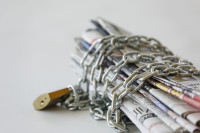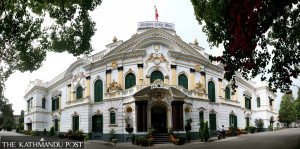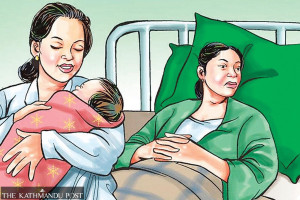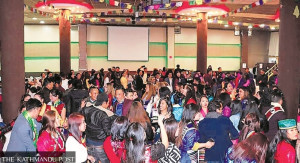Columns
Risks from monarchy
Nepal’s civil society must guard against the broader risks from the growing pro-monarchy movement.
Bishal Thapa
Over the past few months, a political movement seeking to bring back monarchy in Nepal has intensified. The movement’s common rallying cry is “Please come back, oh King. Save the country.”
Monarchy could return. But when it does, there may be no Nepal left for the monarchy to save.
The greatest risk from the continuation of the pro-monarchy movement is that Nepal may splinter, and parts may be tempted to secede from the union. The risks are high, the costs even higher. This is why Nepal’s politically neutral civil society must come together, recognise the risks and push for improvements from our current social, economic and political systems.
A political campaign
When the newly elected Constituent Assembly declared Nepal a federal democratic republic on May 28, 2008, monarchy was abolished. But the 240-year legacy of monarchy has continued to cast a long shadow over Nepali politics. The Rastriya Prajatantra Party (RPP), the pro-monarchy party, advocates for Nepal to return to its previous status of a Hindu state with a monarchy. In 2008, it was the only party to oppose the abolition of monarchy. All four of its members voted against the measure in a constituent assembly with 275 members.
Despite several splits and mergers in its journey, the RPP has retained its core principle, demanding a return to the Hindu state and monarchy. Whenever politically expedient and given the opportunity to govern, it has aligned with parties opposed to the idea of monarchy.
The RPP remains the chief architect of the current pro-monarchy protests. Several of its leaders have been arrested and are in prison awaiting trial. The pro-monarchy movement is fundamentally a fringe political campaign led by a party that currently holds 14 seats in Parliament, out of 275, and secured 5.6 percent of the votes in the last election.
A healthy democracy must allow for all points of view to be discussed, no matter how marginal or fringe, and even if it challenges the core tenets of the constitution. But the appropriate venues for that discourse are in Parliament, media studios, auditoriums, open-air grounds—really, anywhere a microphone can be fitted into a loudspeaker without risking the lives of those listening or obstructing those who want to simply get on with their lives.
This is where Nepal’s civil society must act. More than the government, we must do more to push this discourse to safer grounds so that those who wish to speak and those who wish to listen can do so without risks to life, property or sanity.
Monarchy and the Hindu state
It is unclear whether the pro-monarchy movement is about the demand for a Hindu state or the reinstatement of the monarchy or both. Would it be possible to have a Hindu state but without a monarchy, or a monarchy without a Hindu state?
The RPP, which shepherds this movement, calls for a Hindu monarchy to be reestablished. At some points in its history, the party had dropped the demand for monarchy and retained only its call for a Hindu state.
Throughout its history, Nepal’s monarchy has never been secular. Its authority and rule were intertwined with Hindu faith and beliefs. But times evolve, history moves on. When the monarchy ended, the palaces shut. But temples remained open. Offerings were still made, temple bells still rang and people still prayed.
Over time, our popular understanding of the comingling of monarchy and Hindu beliefs evolved. We understand that Hinduism is about faith, and that monarchy is about a political administrative structure. The two are now distinct in Nepal’s public consciousness. Hindu beliefs in Nepal have remained and continue to be strong. On the other hand, public support for a political administrative structure with a monarch perched at the very top has frayed.
Our Hindu belief system should not be hijacked by a political campaign whose sole aim is to restore monarchy. This would further politicise and corrode faith at a time when Nepal needs it most.
Across Nepal, a deep moral decay appears to be seeping in. We have normalised corruption and cheating within our everyday lives. Our ability to delineate between right and wrong is fuzzy. We have become transactional. We now accept the corruption in our systems. This acceptance has become so entrenched that we have brought it into our homes and in our dealings with friends and family. Our social fabric has become the system, just as corrupt, unjust and unequal.
Nepal needs a spiritual awakening, a moral compass to guide us through these dark times when law, order and systems are falling apart. In this great land of Nepal, home to the centre of Hindu belief, where are our religious and spiritual leaders when we need them the most?
Too busy, I guess, getting the monarch his throne back.
Nepal’s moment of reckoning
Many people have cast the pro-monarchy movement as riding the popular wave of disenchantment, frustration and fatigue with the current political system. Perhaps so. Political movements are often best at catching the wave as it crests. But attributing the movement to public discontent may be an overly simplified interpretation that ignores a deeper, challenging undercurrent running through the country.
Nepal is awakening to its own difficult reckoning, questioning the common national identity that binds it together. The absence of deeply shared common cultural, historical, social or economic experiences that firmly bind all Nepalis within the concept of Nepal is tugging the country in many different directions.
One way to recognise the stress from the national identity crisis is through the immigration outflow from Nepal. The number of people leaving Nepal is much larger than it should be. The high costs, hazards and risks of leaving, against the availability of domestic opportunities (though small), suggest that we are not as rooted to the place, making it easier for us to leave.
Pro-monarchists are seeking to position monarchy as the symbol that will unite Nepal and provide the basis for a national identity. And that is exactly where the gravest risks to Nepal arise.
Nepal’s national psyche has been shaped by subjugation. First the Shah’s, then Rana’s, then the Shah’s again. Our shared experiences and national identity have been shaped by religious, cultural, social, economic and political values that were imposed, not by choice, but by force. Nepalis have overwhelmingly rejected those oppressive symbols of national identity.
The new federal democratic republic is now Nepal’s shared unifying national identity. Rejecting this and seeking to replace it with a monarchy isn’t merely destabilising but runs the risk of seeding separatist movements across the country. Nepal is unlikely to return to a unifying national symbol of subjugation. And without some unifying national symbol, what’s the incentive to remain in the union?
Nepal’s civil society must recognise these risks. They must rise, organise, remain politically neutral and guard against the risks that threaten to rip the country apart. We don’t need a monarch to save us. We need ordinary Nepalis to force their political leadership to perform better. A prosperous federal democratic republic is our best and last hope.




 16.12°C Kathmandu
16.12°C Kathmandu
